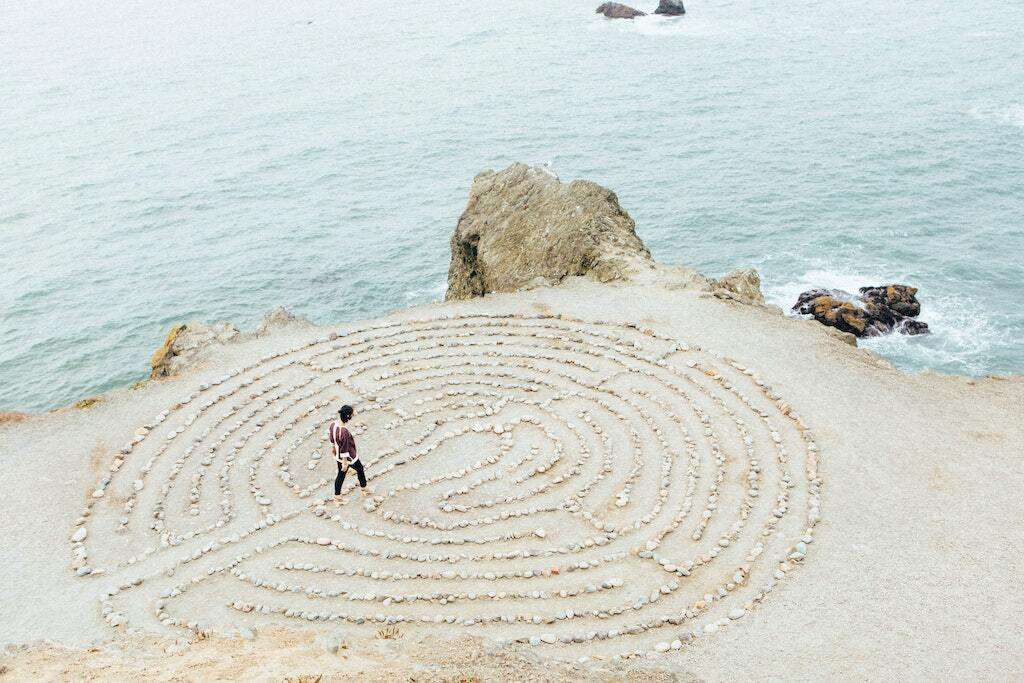Golden Afternoon may be one of the newest IV ketamine therapy clinics to call Santa Monica home, but its ancient therapeutic wisdom coupled with a patient-centered care approach points it toward revolutionizing psychedelic treatment.
As ketamine therapy‘s popularity has increased in recent years — proving effective in treating depression, anxiety, PTSD, mood disorders, and chronic pain, among other issues — Dr. Jennifer Ellice and Somatic Therapist Victoria Webster, co-founders of Golden Afternoon, are leveraging a novel patient care approach, fusing cutting-edge medical techniques with a serene environment.
The founders are Princeton University alumni who ventured down different career paths before uniting their expertise to form the ketamine therapy space. Dr. Ellice, board-certified in emergency medicine, witnessed the transformative potential of ketamine during her tenure in emergency care. Webster, a Certified Core Energetics Practitioner, introduces her integrative practices to the clinic, enhancing the holistic healing approach.
We caught up with founders Dr. Jennifer Ellice and Somatic Therapist Victoria Webster to chat more about the clinic and the benefits of ketamine therapy.
*This interview is edited for length and clarity.
Ethos: As co-founders, how did your shared experience at Princeton contributed to the development of Golden Afternoon?
JE: We both attended college together in the mid-1990s at a time when Princeton could still feel a little like an old boys’ club. Together, we formed some serious sister relationships that have kept us close for decades.
Because Victoria’s father was one of the early investors in the psychedelic boom of the 1960s, she’s had a deep respect for and understanding of the healing properties and the promise of psychedelic medication since she was a child. After so many exciting conversations, we realized that we had a shared vision that we could only realize together and the idea for Golden Afternoon was formed.
VW: Having a business partner who you’ve known for 25-plus years and who you have been college roommates with, is a huge advantage. Jenn and I know each other’s strengths and weaknesses, we know when to push each other and when to back off, and most importantly there is a foundation of trust already in place that allows us to take chances, speak our minds, and have the utmost transparency.
When I was quite young, I heard my father’s stories of experimenting with LSD in the 1950s — he and his friends sitting around a boardroom taking notes. He was hob-knobbing with Aldous Huxley and became an early investor in Dr. Humphrey Osmond’s orthomolecular psychiatry research. He credited his later success in the tech world with the mind-opening properties of the drug, so I grew up positively inclined to psychedelics but never had access to them in a legal, safe environment.
I battled depression most of my life, which led me to different healing modalities. I heard about ketamine and asked Jenn what she thought, and after researching it, she said the science was extremely robust and that I should try it.
I visited two clinics, and while I found the “set and setting” to be lacking: poor bedside manner, loud chaotic environment, and feeling rushed, I had done my own research and arrived with a curated playlist and a guide, my own breathing and grounding exercises. As a result, I experienced a profound transformation, and most of all could see the potential in how far the medicine could go. That was the seed that led to Golden Afternoon.
Ethos: What differentiates Golden Afternoon from other ketamine clinics?
JE: We couldn’t help but notice that existing ketamine clinics resembled a dentist’s office. The environment was often cold and clinical, functional, and unimaginative.
As everyone in the psychedelic world knows, the set and setting are as much a part of the healing experience as the needles and the medication itself.
In all of our decisions, we try to approach our therapeutic goals from the perspective of both “the Sage and the Science.” We say this, because, when it comes to exploring our minds, we feel it’s important to remember that there is a sacrament and a holiness to the healing process, that can’t be rushed or commodified.
Ethos: Can you discuss the role of neuroplasticity in ketamine therapy and how it helps with various mental health conditions?
JE: This is an excellent question and really gets at the core of why ketamine therapy is so revolutionary. Unlike SSRIs and other mood stabilizers that you have to take every day, ketamine works by unleashing your brain’s own healing powers.
Let’s take depression as an example; researchers have shown that depressed people’s brains are different from those of us who are not suffering from depression — their brains appear to have fewer neurons than the brains of “happy” people. It’s postulated that the process of depression somehow causes the brain to “over prune” these areas and cut away some of the neurons that should actually be there for healthy functioning.

After ketamine therapy, we see that these depressed patients have actually managed to grow back these neurons and that their brains start to resemble the brains of their undepressed peers. There’s also been research that shows how ketamine can affect the pineal gland and may promote a more functional circadian rhythm, and also how it can help to re-wire pathways associated with chronic pain, opioid dependence, and other forms of addiction.
But, as with all of the exciting discoveries surrounding psychedelic medicine, we have a lot more to learn. What’s clear is that ketamine works, and that for some people, the effects are dramatic and long-lasting.
Ethos: Could you explain how the environment impacts the patient’s experience and the overall healing process?
JE: The clinic’s name comes from a poem by Lewis Carrol that talks about his inspiration to write Alice in Wonderland, which he came to while enjoying a liminal moment on a ferry one afternoon, staring off and daydreaming.
We both feel strongly about the sanctity and importance of liminal spaces in life. And we wanted to create a place where people can come and feel safe and free to explore their minds and unleash their own healing powers in a setting that feels truly liminal and yet also whimsical at the same time, much like Wonderland.
One of the amazing things about ketamine and other psychedelics is that they promote synaptogenesis, which is when your brain is able to grow new neurons. As humans, we are born with an enormous potential for neuroplasticity. As we age, it decreases.
What psychedelic medicines help us do is to momentarily unleash this potential again, so that we can use our own brain power to heal ourselves and to break out of some harmful or less useful patterns of thinking and feeling.

When we designed the clinic, we wanted to bring each patient back to this frame of mind, to the curious, playful, and free feelings that we have as children, so that each person can leave our clinic inspired to create their own future, their own fresh tracks in the snow.
Ethos: What does a typical ketamine therapy session look like at Golden Afternoon?
JE: We usually start with a video consultation with the doctor, so we can determine if ketamine is going to be helpful and if it can be safely administered. If so, then the patient arrives on the day of the infusion and is taken into a private room, where they are invited to relax in a zero-gravity chair. Our nurse will provide eye masks, noise-canceling headphones, and a personal iPad with a curated music list loaded up for them.
Patients can choose to bring their own music or play ours during the infusion. We monitor their vitals and we discuss what to expect during the treatment and afterwards. We offer to walk them through some light breathing exercises and we invite them to set an intention for the journey. When they are ready, we start the infusion and we monitor them remotely during their journey. We also check in on them in person every 15 minutes. They are invited to take their journey alone or bring a partner, a friend, or a guide if they prefer. (Most people prefer to be alone.)
After about 45 minutes, when the infusion is over, we let them know and disconnect them from the IV. They are then invited to rest for another 20-30 minutes or so or until they feel that their journey is complete. At this point, we invite them to do some simple grounding exercises to help them integrate back and reorient. This is not required, and some patients prefer to stretch, talk or even sing or move instead. We offer them a journal, herbal tea, and a light snack and if they feel inspired to share any of their insights or revelations, our staff will help them to process and record their discoveries.
Ethos: How do you navigate and manage the experience that comes with ketamine therapy to ensure it’s a positive and therapeutic process for the patient?
JE: We feel it is critically important for our patients to keep working with their therapists and their psychiatrists during the treatment course. We encourage them to continue any SSRIs or other psychiatric medications that they may already be taking. While some of our patients are looking to wean off of their daily medications, we encourage them to wait to work on this after their course of treatment and to do so in conjunction with their doctor or therapist.

Before each infusion, we encourage patients to take some time to really think about their intentions for the treatment and to try to remain curious and open to whatever comes up during their experience, so that they can bring their insights to their therapist or their doctor afterward.
After each infusion, we try to help each patient take time in the following 24 hrs to perform their “praxis” which can be any form of doing that best represents their intention. This can be journaling, drawing, going for a walk or even just lighting a candle. The idea is to take some time out of the day to put their intention into practice, in a way that solidifies and sanctifies their goals for change.
Ethos: Post-treatment, patients are led through a series of grounding exercises. Could you share the purpose behind this and how it aids in the patient’s reintegration?
JE: Ketamine is a dissociative anesthetic agent, which means that part of the mechanism by which it works is that it temporarily dissociates you from the sensory input of your somatic body. Patients will often describe feeling as if they are “floating” or “twisting off” from their bodies and from their physical presence. This dissociation can be incredibly therapeutic as it sometimes allows for a fresh perspective on old habits, feelings, and associations.
Patients often describe that they are able to see themselves and their bodies with compassion in ways they’ve never felt before. When the infusion is over and as the medication starts to wear off, there can be a novel feeling associated with “coming back” into one’s physical body.
For most people, the return is intuitive, but for those who might feel disoriented, we employ a series of grounding exercises to help with the reintegration. By gently moving them through some tailored exercises and breathwork, we can help with this process and ensure that everyone feels safe and whole before they are discharged.
Ethos: What are the biggest challenges ketamine and other psychedelic substances are facing in the alt-treatment arena? How are you approaching those?
JE: One of the bigger challenges is overcoming the stigma that’s associated with psychedelic medicine. Unfortunately, because of the sociopolitical forces of the last century, we are still left with the challenge of convincing governments, insurance companies, and patients all over the world who still think of these medications as “drugs.” But this is changing, in large part, because of the sheer volume and quality of the research that’s coming out. People are waking up to the radical idea that mental health matters; for our soldiers, for our teachers, for our healthcare providers, for our children — and, really, for each and every one of us.
Another challenge that we need to address actively is how best to make psychedelic medicine accessible to people from diverse backgrounds, cultures, and ethnicities. One thing that Victoria and I both struggle with is the legacy of white privilege that’s permeated the conversation about psychedelics since the end of the last century.

Psychedelic medicine is not new to humanity. This body of knowledge, long cultivated, improved upon, and discovered by Indigenous people was co-opted and commodified by privileged elites, and ironically, criminalized and policed most often amongst people of color and those who were less economically advantaged. As a result, the advantages of psychedelic medicine are still mostly being realized by the privileged.
We would both love to hear more diverse voices join the conversation about psychedelics and other alternative therapies so we can all benefit from this ancient and powerful healing modality.
Ethos: How do you see ketamine evolving mental health care and how that intersects with our relationships with each other and a planet in crisis? Can ketamine make us better global citizens?
JE: Timothy Leary famously invited people to “turn on, tune in, drop out,” but ironically, many of my patients return from their journeys with a totally different perspective; they come back with a profound sense of awe and interconnectedness that inspires them to engage more with their families, their friends, their communities. Many patients have visions of their ancestors or loved ones who have passed away. Almost everyone talks about seeing how valuable and precious their relationships are with others.
One of my favorite insights came from a patient who told me that during one of his infusions, he was suddenly able to “see” that the whole of human existence was a symphony, so beautiful and complex.
He explained that while he listened, he was able to hear the individual notes of his own existence, but that in the context of this grand symphony, his personal discontent, his private anxieties, and insecurities were but little tiny notes of discord in a swelling and unimaginably powerful song. I think about that a lot. If only more people could hear that symphony for a little while, perhaps we could all raise our wounded voices together and make our ancestors proud.
Golden Afternoon is located at 1450 10th Street, Suite 300, Santa Monica, CA 90401.
Related on Ethos:


